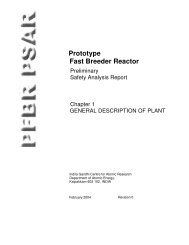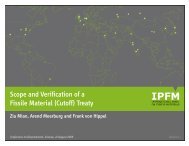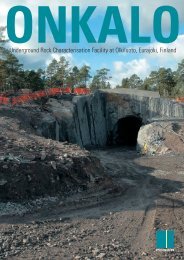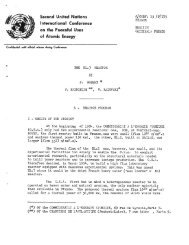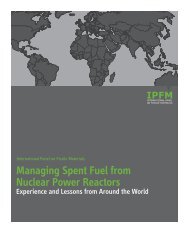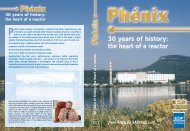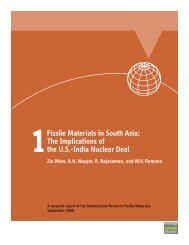Nuclear Proliferation TechnologyTrends Analysis - International ...
Nuclear Proliferation TechnologyTrends Analysis - International ...
Nuclear Proliferation TechnologyTrends Analysis - International ...
Create successful ePaper yourself
Turn your PDF publications into a flip-book with our unique Google optimized e-Paper software.
PNNL -14480<br />
Table 3 lists the fourteen countries that have expressed interest in acquiring gaseous<br />
diffusion enrichment technology. Of these, five had a successful indigenous program,<br />
and one (China) purchased the technology.<br />
Argentina 2 Italy 2<br />
Belgium 1 Japan 1<br />
China 3 The Netherlands 2<br />
France 3 Soviet Union 3<br />
Germany 2 Spain 1<br />
Iran 1 United Kingdom 3<br />
Iraq 1 United States 3<br />
1 Research and development, 2 Pilot plant, 3 Industrial facility<br />
Table 3 Countries interested in gaseous diffusion enrichment technology<br />
Table 4 lists the six countries that have had successful gaseous diffusion programs, and<br />
the time frames involved in the completion of the initial phase of these programs for each<br />
country. All of these facilities had significant problems in initial operation. So, the dates<br />
shown are of the first reported throughput and not necessarily the first successful<br />
production of HEU. Most of theses facilities (except in Argentina, Section 3.1.3.6) were<br />
initially intended to produce weapons material rather than for commercial production,<br />
were national priorities, and were funded as such.<br />
3.1.3.1 United States<br />
The United State had constructed three gaseous diffusion enrichment facilities by 1954.<br />
Originally intended to supply highly-enriched uranium for weapons programs, these<br />
facilities operated for over forty years.<br />
Construction of the first U.S. facility began in 1943, with small quantities of enriched<br />
uranium available in 1945. The plant, however, did not produce significant quantities of<br />
HEU until about 1947.<br />
Two later plants, Paducah (began construction 1950, first product 1952) and Portsmouth<br />
(began construction 1952, first product 1956), began production of low-enriched uranium<br />
for use in commercial nuclear fuel in the mid 1960’s 6 . During most of their operating<br />
life, these facilities operated at over a 90% plant capacity factor 6 . By 1976, these<br />
gaseous diffusion plants had provided more than 90% of the enriched uranium for the<br />
western world's nuclear power plants.<br />
As with all initial or early gaseous diffusion facilities, there were significant initial<br />
problems to be solved before operations could proceed. Currently, only one U.S. gaseous<br />
diffusion plant remains in operation.<br />
Time from initial construction to first operation ranged from two to four years; for the<br />
first facility, time from construction start to HEU was four years.<br />
6 United States Enrichment Corporation (USEC) Facilities fact sheet.<br />
8



